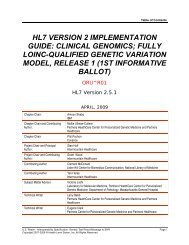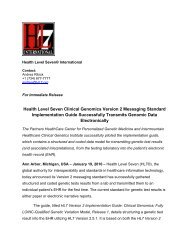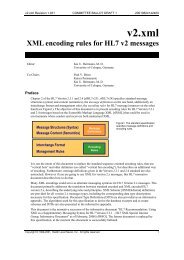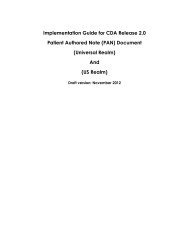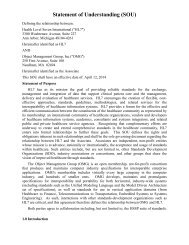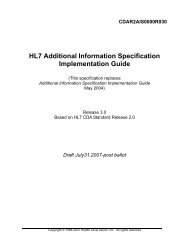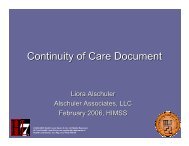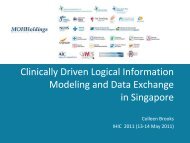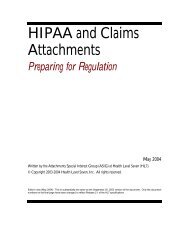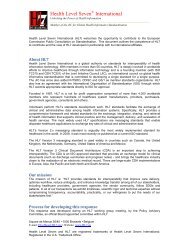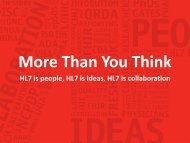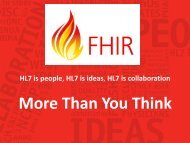Standards in Clinical Decision Support - Duke Center for Health ...
Standards in Clinical Decision Support - Duke Center for Health ...
Standards in Clinical Decision Support - Duke Center for Health ...
Create successful ePaper yourself
Turn your PDF publications into a flip-book with our unique Google optimized e-Paper software.
Welcome to Workshop 4<strong>Standards</strong> <strong>in</strong> Cl<strong>in</strong>ical <strong>Decision</strong> <strong>Support</strong>:Activities <strong>in</strong> <strong>Health</strong> Level SevenAnd Beyond
Background• Workshop: A sem<strong>in</strong>ar, discussion group, or the like,which emphasizes exchange of ideas and thedemonstration and application of techniques, skills, etc.Random House Dictionary of the English LanguageCollege EditionNew York: Random House, 1969
Discussants• Robert A. Jenders, MD, MS, FACP, FACMIProfessor, Department of Medic<strong>in</strong>eCedars-S<strong>in</strong>ai Medical <strong>Center</strong>University of Cali<strong>for</strong>nia, Los AngelesCo-Chair, HL7 Cl<strong>in</strong>ical <strong>Decision</strong> <strong>Support</strong> Work GroupCo-Chair, Arden Syntax Work GroupDiscussant, Arden Syntax + GELLO
Discussants• Guilherme Del Fiol, MD, PhDAssistant Professor, Division of Cl<strong>in</strong>ical In<strong>for</strong>maticsDepartment of Community and Family Medic<strong>in</strong>e<strong>Duke</strong> University <strong>Health</strong> System, Durham, North Carol<strong>in</strong>aDeveloper, Infobutton Standard• Kensaku Kawamoto, MD, PhDAssistant Professor, Division of Cl<strong>in</strong>ical In<strong>for</strong>maticsDepartment of Community and Family Medic<strong>in</strong>e<strong>Duke</strong> University <strong>Health</strong> System, Durham, North Carol<strong>in</strong>aCo-Chair, HL7 Cl<strong>in</strong>ical <strong>Decision</strong> <strong>Support</strong> Work GrouDeveloper, <strong>Decision</strong> <strong>Support</strong> Service standard
Overview of Workshop• Part 1: Overview of HL7 CDS (Jenders)• Part 2: Proposed standards– vMR project– Order Set project– HQMF project• Part 3: Current standards– Arden Syntax (Jenders)– GELLO (Jenders)– Infobutton (Del Fiol)– DSS (Kawamoto)• Part 4: Your <strong>in</strong>put
HL7 Structure: Cl<strong>in</strong>ical <strong>Decision</strong> <strong>Support</strong>• Consensus-based, ANSI-accredited SDO– 20+ <strong>in</strong>ternational affiliates– Meet<strong>in</strong>gs (3/year): 400 participants• Cl<strong>in</strong>ical <strong>Decision</strong> <strong>Support</strong> Work Group (Jenders,Greenes, Kawamoto, Parker)– Contribute to RIM, <strong>in</strong><strong>for</strong>m CDS aspects of otherHL7 work, develop overall decision support systemmodel– Related to Arden Syntax Work Group
HL7 Structure: Cl<strong>in</strong>ical <strong>Decision</strong> <strong>Support</strong>• Interactions with other groups: EHR Work Group,Patient Care Work Group, etc• Coord<strong>in</strong>ation via the Technical Steer<strong>in</strong>g Committee:– Structure and Semantic Design– Foundation and Technology– Doma<strong>in</strong> Experts– Technical and <strong>Support</strong> Services
HL7 CDS: External Relationships• HITSP– Coord<strong>in</strong>ate development of work products thatfulfill HITSP use cases– Examples: Order set standard, Infobuttonstandard, guidel<strong>in</strong>e <strong>for</strong>malism• OMG– DSS• ONC– CDS Collaboratory
HL7 CDS: External Relationships• Morn<strong>in</strong>gside Initiative– Initiated 8/2007– Goal: Interoperable delivery of CDS at POC– Multiple participants: AMIA (umbrella),Partners, Intermounta<strong>in</strong>, ASU, etc– Artifacts• Knowledge module repository• Edit<strong>in</strong>g, management tools– Current status: Draft bylaws written; committeesorganized; <strong>in</strong>itial knowledge acquisition related todiabetes guidel<strong>in</strong>es. KR <strong>for</strong>malism not yetselected.
HL7 Contacts• http://www.hl7.org– Co-chair names/contact <strong>in</strong><strong>for</strong>mation– Mission statements– Meet<strong>in</strong>g m<strong>in</strong>utes– Official standards
Aspects of Standardization• Structure: Knowledge representation– Enable shar<strong>in</strong>g• Messag<strong>in</strong>g: Format, term<strong>in</strong>ology– Enable <strong>in</strong>teroperability• Function: Services
Work Product:Proposed Virtual Medical Record (vMR)Standard• Def<strong>in</strong>ition: Data model and implementation guide,based on the HL7 v3 RIM <strong>for</strong>mat, <strong>for</strong> represent<strong>in</strong>gcl<strong>in</strong>ical <strong>in</strong><strong>for</strong>mation <strong>in</strong>puts and outputs to/from cl<strong>in</strong>icaldecision support services– Initial focus: <strong>Support</strong> POC chronic diseasemanagement• Functionality: Cl<strong>in</strong>ical <strong>in</strong><strong>for</strong>mation systems use astandard model to represent data communicated with acl<strong>in</strong>ical decision support system• Status: Work started on creation of UML model =HL7 Doma<strong>in</strong> Analysis Model <strong>in</strong> September, 2009
Work Product:Proposed Order Set Standard• An order set is a functional group<strong>in</strong>g of orders <strong>in</strong>support of a protocol that is derived from evidencebased best practice guidel<strong>in</strong>es.– Order sets have a purpose.– Order sets may conta<strong>in</strong> conditional logic.– Some items <strong>in</strong> an order set may be fully specified,others may have more optionality.– Order sets may be part of a larger care plan.
Order Sets• In Scope– Create a structural and functional model tocommunicate order set content between contentauthors and those who will use the content.• Out of Scope– The result of this project will NOT be a standard <strong>for</strong>messag<strong>in</strong>g orders at the po<strong>in</strong>t of care.
Order Sets: Layers• I – Publish, Distribute and Track: Metadata <strong>for</strong> author<strong>in</strong>g,ma<strong>in</strong>tenance and dissem<strong>in</strong>ation by professional standardsorganizations• II - Import: Full text order set content permits localizationand use with<strong>in</strong> vendor EHR: Order tests, treatments andprocedures, set Goals, record Observations• III – Presentation management: Organize and restrict ordersession content <strong>for</strong> maximum cl<strong>in</strong>ical utility• IV - Manage as knowledge: Coded standards-based ordercontent supports manipulation of order sets, order segmentsand order items by guidel<strong>in</strong>e decision support eng<strong>in</strong>e
Order Sets: Structure• Order set = header + body• Header: Attributes– Ownership– Authorship– Ma<strong>in</strong>tenance– Scope of Use– Related Order Sets (Nest<strong>in</strong>g)– Description– <strong>Support</strong><strong>in</strong>g Evidence– Use Cases– Authorship Milestones– Context <strong>for</strong> Use
Order Sets: Status• September, 2008: Passed DSTU ballot– Had previously failed ballots because of disputesover the data model• Current status: Regroup<strong>in</strong>g to resume work onproposed standard
Ancillary Work Product:Proposed HQMF• Increas<strong>in</strong>g mandates <strong>for</strong> cl<strong>in</strong>ical per<strong>for</strong>mancemeasurement– Pay <strong>for</strong> per<strong>for</strong>mance– CMS: No payment <strong>for</strong> hospital-acquired conditions– Competitive measurement: hospitalcompare.gov• Implementation of quality <strong>in</strong>dicators (QIs) can becostly– Need to translate published QI to computable <strong>for</strong>m– Need to collect digital data <strong>in</strong> structured <strong>for</strong>mat– Otherwise, paper-based collection is time- andresource-<strong>in</strong>tensive
Quality Indicators: Sample ACOVE QIs• IF a vulnerable elder has had a myocardial <strong>in</strong>farction,THEN he or she should be offered a beta blocker unlessthere is a contra<strong>in</strong>dication• IF an ambulatory vulnerable elder has an osteoporoticfracture diagnosed, THEN physical therapy or anexercise program should be offered with<strong>in</strong> 3 months• IF a vulnerable elder is tak<strong>in</strong>g warfar<strong>in</strong> <strong>for</strong> atrialfibrillation, THEN an INR should be checked at leastevery 6 weeks
HQMF• No standard <strong>for</strong>malism <strong>for</strong> knowledge representation• Standardization ef<strong>for</strong>ts underway– AMA Collaborative <strong>for</strong> Per<strong>for</strong>mance MeasureIntegration with EHR Systems– HL7: <strong>Health</strong>care Quality Measure Format (HQMF)be<strong>in</strong>g developed as a draft standard <strong>for</strong> trial use(DSTU) = v3 RIM-based XML• Cl<strong>in</strong>ical guidel<strong>in</strong>e standards exist but may not beapplicable– QIs are population-based, but guidel<strong>in</strong>e <strong>for</strong>malismsare applied to <strong>in</strong>dividual patients
HQMF
HQMF: Status• Passed DSTU ballot September, 2009• Extensive reconciliation undertaken• Publication ef<strong>for</strong>ts underway
Extant <strong>Standards</strong>• Arden Syntax• GELLO• Infobutton• DSS
Arden Syntax <strong>for</strong> Medical Logic Modules• Modular knowledge bases which are <strong>in</strong>dependent fromone-another• Share medical knowledge, not just reuse• Procedural representation of medical knowledge• Discrete units of knowledge = Medical Logic Module(MLM)• Explicit def<strong>in</strong>itions <strong>for</strong> data elements• HL7 / ANSI / ISO Standard• Current version: 2.7
MLM Format• Three categories and a term<strong>in</strong>ator• Categories– ma<strong>in</strong>tenance:– library:– knowledge:– resources: (new <strong>in</strong> v2.6)• Term<strong>in</strong>ator– end:
MLM Examplema<strong>in</strong>tenance:title: Admission Screen <strong>for</strong> Acute Coronary Artery Disease;;filename: ACUTE_CAD_1;;version: 1.09;;<strong>in</strong>stitution: Columbia-Presbyterian Medical <strong>Center</strong>;;author: Robert Jenders, MD, MS (jenders@cucis.cis.columbia.edu);;specialist: Alan Simon, MD (ads5@columbia.edu);;date: 1996-01-24;;validation: research;;library:purpose: To notify <strong>in</strong>vestigators of the admission of a patientwhose admission diagnosis suggests acute coronary arterydisease. IRB number 7205;;explanation: ;;keywords: ;;citations: ;;
knowledge:MLM p. 2type: data-driven;;data:admission := event {'32511','32467'; '32511','32472'};<strong>in</strong>patient_case := read last {'evok<strong>in</strong>g','dam'="GYDAPMP",'constra<strong>in</strong>ts'=" I***";"HCASE";"K"}; /* note blank as first constra<strong>in</strong>t char */email_dest := dest<strong>in</strong>ation {'email','name'= "rra2@columbia.edu"};diagnosis_text := read {'evok<strong>in</strong>g','dam'="GYDAPMP"; "HDIAGNOS"; "HDIAGTXT"};target_diagnoses := ("MI","R/O MI","MYOCARDIAL INFARCTION","CARDIOGENIC SHOCK","CHEST PAIN","CP","ANGINA","CHEST PAIN NOS","INTERMED CORONARY SYND","UNSTABLE ANGINA","CAD","ANGINA PECTORIS NOS","CHR ISCHEMIC HRT DIS NEC","RULE OUT MI","R/O MYOCARDIAL INFARCTION","ACUTE MI","SUBENDO INFARCT","UNSTABLE ANGINA/MI","ANGINA PECTORIS","CORONARY ARTERY DISEASE");mrn := read last {'pcodes'="now mrn "};patient_name := read last {'dam'="GYDAPMP"; "HPBASIC"; "HNAME"};location := read last {'dam'="GYDAPMP"; "HLOC"; "HLOCNURS"};;;
evoke: admission;;logic:if <strong>in</strong>patient_case is null thenconclude false;endif;if any (diagnosis_text are <strong>in</strong> target_diagnoses) thenconclude true;elseconclude false;endif;;;action:write "ACUTE CAD ADMISSION NOTICE" ||"\n\nPatient Name: " || patient_name ||"\nMRN: " || mrn ||"\nLocation: " || location ||"\nAdmission Diagnosis: " || diagnosis_text ||"\n\n\n" || patient_name || " " || mrn || " " || locationat email_dest;;;end:MLM p. 3
System Vendors• Eclipsys• McKesson• Siemens• Medexter
Resources• Official Archive: www.hl7.org• HL7 Library or Book Store to obta<strong>in</strong> authoritative copy ofstandard• Work Groups / Arden Syntax <strong>for</strong> committee’s homepage
Arden Syntax v2.8• Timel<strong>in</strong>e: Normative ballot 1/2011• 2 key advances– Fuzzy logic: Represent l<strong>in</strong>guistic variables +operators to manipulate these• “moderately severe”; “potentially associated”– XML (“Arden ML”): Ref<strong>in</strong>e present non-normativeXML version of Arden• Stepwise ref<strong>in</strong>ement of different levels ofmarkup: MLM -> category -> slot -> statement-> operator
Arden Syntax v3.0• Timel<strong>in</strong>e: Indef<strong>in</strong>ite future• Potential <strong>in</strong>gredients– Further elaborate structured WRITEstatement (i.e., expansion of the Action slot)– vMR– <strong>Support</strong> <strong>for</strong> complex guidel<strong>in</strong>es, e.g.,“master MLMs” that document packagesof MLMs and their dependencies– Additional logics: Other methods <strong>for</strong>address<strong>in</strong>g uncerta<strong>in</strong>ty (e.g., probabilityconstructs)– Workflow constructs, <strong>in</strong> part to enable anauthor<strong>in</strong>g/development environment
Arden Syntax v3.0• Potential <strong>in</strong>gredients (cont<strong>in</strong>ued)– Reference implementation + con<strong>for</strong>mancemodel (<strong>in</strong> part as verification of particularimplementations)– Author<strong>in</strong>g/ma<strong>in</strong>tenance environmentsyntactical constructs– <strong>Support</strong> <strong>for</strong> term<strong>in</strong>ology references + a datamodel– <strong>Support</strong> <strong>for</strong> quality measure implementation– <strong>Support</strong> <strong>for</strong> data <strong>in</strong>terface (e.g., expansion ofthe READ statement; ask now vs laterdirected at synchronous users)
GELLO = Common Expression Language• Executable language <strong>for</strong> express<strong>in</strong>g logical rules andqueries <strong>in</strong> cl<strong>in</strong>ical decision support applications• Provides a standard <strong>in</strong>terface to medical recordsystems and other data/knowledge sources– Based on OMG OCL• GELLO expressions:– Extract and manipulate data– Construct decision criteria, abstractions, <strong>for</strong>mulae
GELLO = Common Expression Language• Purpose: Share queries and logical expressions– Query data (READ)– Logically manipulate data (IF-THEN, etc)• Initial rationale: Stepp<strong>in</strong>g stone to a RIM-compliantguidel<strong>in</strong>e <strong>for</strong>malism• Initial version: ANSI standard release 1 = May, 2005Ogunyemi O, Zeng Q, Boxwala A. Object-oriented guidel<strong>in</strong>e expressionlanguage (GELLO) specification: Brigham and Women’s Hospital,Harvard Medical School, 2002. <strong>Decision</strong> Systems Group TechnicalReport DSG-TR-2002-001.
GELLO: Examples QueriesObservation.select(coded_concept=’03245’)Observation.selectSorted(coded_concept=“C0428279”)Expressions• The variables calcium and phosphate are not nullcalcium.notEmpty() and phosphate.notEmpty()• The patient has renal failure and the product of calcium andphosphate exceeds a threshold signify<strong>in</strong>g osteodystrophyrenal_failure and calcium_phosphate_product > threshold_<strong>for</strong>_osteodystrophy
GELLO: Status• 2006– Tool release by Medical Objects (Australia)– Demonstration project: e-Prescrib<strong>in</strong>g priorauthorization rules
GELLO: Status• 2007– Author<strong>in</strong>g tool release by InferMed (UK).– Demonstration projects• Possible: Cl<strong>in</strong>ical trial• Australia (Medical Objects + HaematologySociety + Leukaemia Society of Australia):Guidel<strong>in</strong>e representation <strong>in</strong> a GLIF context– Result of demonstration projects• BNF revision• Work on vMR as a RIM-derived data model <strong>for</strong>decision support
GELLO: Status• 2008: Two work products– v 1.0: Revision of BNF to fix errors– v 2.0: Expand <strong>in</strong> light of prior testbed projects• 2009: Further ref<strong>in</strong>ement– v 2.0: Passed <strong>in</strong>itial normative ballot 9/2009
Mov<strong>in</strong>g right along…• Arden Syntax• GELLO• Infobutton• DSS
Discussion Questions• Overall– How do I get <strong>in</strong>volved?– Need <strong>for</strong> shared knowledge repository?• Infobutton– Where can I get them?– How should the standard be improved?• DSS– What types of knowledge modules are useful?– Would you use a DSS provider?– Do we need a guidel<strong>in</strong>e representation <strong>for</strong>malism?
Discussion Questions• Arden– Where can I get a rules eng<strong>in</strong>e?– Where can I get “rules”?• HQMF– How will organizations use this?• Order Set– Will an HL7 standard matter <strong>in</strong> the sett<strong>in</strong>g of a defacto standard?
The Endjenders@ucla.eduguilherme.delfiol@duke.edukawam001@mc.duke.eduThanks!
Context-aware Knowledge Retrieval(Infobutton) StandardGuilherme Del Fiol, MD, PhDAssistant ProfessorDivision of Cl<strong>in</strong>ical In<strong>for</strong>maticsDepartment of Community and Family Medic<strong>in</strong>e<strong>Duke</strong> Universityguilherme.delfiol@duke.edu
Po<strong>in</strong>t-of-care <strong>in</strong><strong>for</strong>mation needs2 questions out of every3 patients seen (Covell, 1985)ContextEHRi> 50% of questionsleft unanswered (Ely, 2005)‹#›
TopicsResources‹#›
Electronic<strong>Health</strong>RecordiAzithromyc<strong>in</strong>Female81 yearsUser: MDOrder entryAPIInfobuttonManagerAPIResourcesMicromedex& topicsAdult DoseAzithromyc<strong>in</strong>Female81 years‹#›
Why did we need a standard?• Lack of a common understand<strong>in</strong>g of“context”– In<strong>for</strong>mation model– Term<strong>in</strong>ologies• Numerous resources available– Answers not likely to be found <strong>in</strong> ones<strong>in</strong>gle resource– Not designed <strong>for</strong> <strong>in</strong>fobutton <strong>in</strong>tegration– Non-scalable <strong>in</strong>tegration• Implementations l<strong>in</strong>k<strong>in</strong>g to a s<strong>in</strong>gle resource‹#›
No standard <strong>in</strong> placehttp://resource1.com/search = “azithromyc<strong>in</strong> AND dosehttp://resource2.com/query =“azithromyc<strong>in</strong>” [MeSH Terms]AND dose [All Fields]APIResource 1Electronic<strong>Health</strong>RecordiAPIInfobuttonManagerAPIResource 2http://resource3.com/searchConcept = 3333 ^ azithromyc<strong>in</strong>filter = 11 ^ dosageAPIResource 3‹#›
Overview of the Standard• Standard mechanism to express andcommunicate EHR “context”• HL7 v3 standard– Messages• Infobutton request• Infobutton response (under development)– Implementations• XML and URL-based• SOA (under development)• Standard term<strong>in</strong>ologies– RxNorm, LOINC, SNOMED-CT, MeSH– “Free-text” is an option to allow fasteradoption‹#›
Infobutton – Current statusInfobuttonrequest HTMLInfobuttonrequestHL7Resource 1Electronic<strong>Health</strong>RecordiHL7InfobuttonManagerHL7Resource 2HL7Resource 3HTML‹#›
Participants• <strong>Health</strong> care & academic <strong>in</strong>stitutions– <strong>Duke</strong> University, Intermounta<strong>in</strong><strong>Health</strong>care, NIH Cl<strong>in</strong>ical <strong>Center</strong>,Columbia University, Partners<strong>Health</strong>care, VA, Cedars-S<strong>in</strong>ai, KaiserPermanente• Content providers– Wolters Kluwer <strong>Health</strong>, ThomsonReuters, NLM, UpToDate, Ebsco,<strong>Health</strong>wise, ACP, Elsevier, Lexicomp• EHR vendors– GE, Epic, Eclipsys, Siemens‹#›
Example• The user is look<strong>in</strong>g at a problem listof a female, 97 years-old patientwith Heart Failure. The user clicks onan <strong>in</strong>fobutton that presents a seriesof questions. The user selects “Howdo I treat Heart Failure?”‹#›
displayName="therapy"/>‹#›
URL-based Implementation• More compatible with current EHRunderly<strong>in</strong>g <strong>in</strong>frastructures– Faster adoption• Rules <strong>for</strong> automated conversion– URL can be automatically derived fromXML message‹#›
From XML to URL
age.v=94age.u=aadm<strong>in</strong>istrativeGenderCode.c=Fma<strong>in</strong>SearchCriteria.c.c=2823-3ma<strong>in</strong>SearchCriteria.c.cs=2.16.840.1.113883.6.1taskContext.c.c=LABRREVma<strong>in</strong>SearchCriteria.c.dn=Serum potassiumma<strong>in</strong>SearchCriteria.c.ot=K<strong>in</strong>terpretationCode.c.c=L‹#›
age.v.v=0.05age.v.u=apatientPerson.adm<strong>in</strong>istrativeGenderCode.c=FtaskContext.c.c=PROBLISTREVsubTopic.c.c=Q000628subTopic.c.dn=therapysubTopic.c.cs=2.16.840.1.113883.6.177ma<strong>in</strong>SearchCriteria.c.c=372.00ma<strong>in</strong>SearchCriteria.c.cs=2.16.840.1.113883.6.103ma<strong>in</strong>SearchCriteria.c.dn=Acute Conjunctivitis‹#›
Current Status• Infobutton knowledge request– Draft Standard <strong>for</strong> Trial Use (DSTU)– HITSP• T81 - Retrieve Medical Knowledge• One of the EHR capabilities (CAP 122)– URL-based implementations• 15+ large scale implementations• Work<strong>in</strong>g demonstration at AMIA 2007• Several ongo<strong>in</strong>g development ef<strong>for</strong>ts‹#›
• Infobutton DSSOngo<strong>in</strong>g Work– Services Oriented Architecture (SOA)– <strong>Support</strong>s enhanced <strong>in</strong>tegration• Standardized knowledge response– Leverages exist<strong>in</strong>g standards• HL7/OMG <strong>Decision</strong> <strong>Support</strong> ServicesStandard• Atom (IETF)– Ballot <strong>for</strong> comments – Sep 2009‹#›
Infobutton SOAInfobuttonKnowledge Retrieval Knowledge RetrievalSOAInfobutton request (DSTU)Metadata Metadatarequest (DSTU)HL7Drug KBEHRiSOAHL7SOAHL7DiseasesInfobuttonManagerSOAHL7Patienteducation‹#›
Infobutton DSS Request‹#›
Requested Knowledge Module‹#›
Infobutton DSS Request‹#›
Data Requirements‹#›
Request Payload‹#›
Infobutton DSS Response‹#›
Response Payload‹#›
Response Payload‹#›
Timel<strong>in</strong>eInfobuttonRequest(DSTU)InfobuttonRequest(Normative)Jan 2008 Sep 2009 Jan 2010 May 2010Infobutton DSS(For comments)Infobutton DSS(DSTU)‹#›
• Make it simpleLessons Learned• Make it easy to understand andimplement• Target quick adoption– Make it compatible with implementers’current <strong>in</strong>frastructure• Provide plenty of examples• Validate with real implementations‹#›
www.hl7.org/v3ballot2008MAY/html/welcome/environment/Guilherme.delfiol@duke.edu‹#›
HL7-OMG <strong>Health</strong>care Services Specification Project(HSSP) and HSSP <strong>Decision</strong> <strong>Support</strong> ServiceStandard – Current Status and Future DirectionsNovember 13, 2009Kensaku Kawamoto, M.D., Ph.D.Assistant ProfessorDivision of Cl<strong>in</strong>ical In<strong>for</strong>maticsDepartment of Community and Family Medic<strong>in</strong>eMember, Institute <strong>for</strong> Genome Sciences & Policy<strong>Duke</strong> University Medical <strong>Center</strong>kawam001@mc.duke.edu© 2009,KensakuKawamoto
Disclosure• The research underly<strong>in</strong>g the DSS specification hasbeen funded <strong>in</strong> part by grants from:• The National Library of Medic<strong>in</strong>e• The Agency <strong>for</strong> <strong>Health</strong>care Research and Quality• The <strong>Health</strong> Resources and Services Adm<strong>in</strong>istration• The National Human Genome Research Institute• F<strong>in</strong>ancial disclosures• Dr. Kawamoto is a co-owner of Cl<strong>in</strong>ica, Inc., which holds IP rightsto a CDS technology known as SEBASTIAN. A patent applicationon the SEBASTIAN technology has been filed.• Dr. Kawamoto and <strong>Duke</strong> University may benefit f<strong>in</strong>ancially ifproducts utiliz<strong>in</strong>g SEBASTIAN are commercially successful.• SEBASTIAN represents just one of potentially many approaches<strong>for</strong> <strong>in</strong>stantiat<strong>in</strong>g an HL7 <strong>Decision</strong> <strong>Support</strong> Service.© 2009,KensakuKawamoto
Agenda• <strong>Health</strong>care Services Specification Project• Overview• Current Status• Future Directions• HSSP <strong>Decision</strong> <strong>Support</strong> Service Standard• Overview• Current Status• Future Directions• Discussion Questions© 2009,KensakuKawamoto
<strong>Health</strong>care Services Specification Project• Ef<strong>for</strong>t to standardize functionality, semantics,and <strong>in</strong>terfaces of services important to health IT• Initiated <strong>in</strong> 2005 as jo<strong>in</strong>t ef<strong>for</strong>t between HL7 andObject Management Group (OMG)• OMG: vendor consortium produc<strong>in</strong>g enterprise<strong>in</strong>teroperability specifications; specified UML & CORBA• Described <strong>in</strong> upcom<strong>in</strong>g JAMIA article• Kawamoto K, Honey A, Rub<strong>in</strong> K. The HL7-OMG <strong>Health</strong>careServices Specification Project: Motivation, Methodology, andDeliverables <strong>for</strong> Enabl<strong>in</strong>g a Semantically Interoperable Service-Oriented Architecture <strong>for</strong> <strong>Health</strong>care. JAMIA, 2009 [<strong>in</strong> press].© 2009,KensakuKawamoto
HSSP ProcessIdentify standardization candidatesHL7 Process(~1.0 - 1.5 yrs)Specify Service Functional Model (SFM)[def<strong>in</strong>es functionality, <strong>in</strong>terfaces, and semantics*]Adopt SFM as HL7 Draft Standard <strong>for</strong> Trial Use (DSTU)Issue OMG request <strong>for</strong> technical specificationsOMG Process(~1.5 - 2.0 yrs)Vendors generate common service <strong>in</strong>terface specificationand additional semantic profiles*Technical service specification adopted as OMG standardCommercial service implementations available*Service semantics also specified <strong>in</strong> separately balloted semantic profiles© 2009,KensakuKawamoto
HSSP – Current StatusServiceHL7 SFMadoptedOMG spec.adoptedEntity Identification Service X XRetrieve, Locate, & Update Service X X<strong>Decision</strong> <strong>Support</strong> Service X Anticipated12/09Common Term<strong>in</strong>ology Services 2Cl<strong>in</strong>ical Research Filtered QueryService<strong>Health</strong>care, Community Servicesand Provider Directory, Release 1Privacy, Access, and SecurityServicesXXX© 2009,KensakuKawamoto
HSSP – Future Directions• Cont<strong>in</strong>ue development of HL7/OMG standards• Projects actively seek<strong>in</strong>g <strong>in</strong>terested contributors• Facilitate adoption and use• E.g., via Open <strong>Health</strong> Tools(http://www.openhealthtools.org/)• Chief <strong>Health</strong> In<strong>for</strong>matics Officer of Open <strong>Health</strong> Tools:Dr. Robert Kolodner, <strong>for</strong>mer head of ONCHIT andVeterans <strong>Health</strong> Adm<strong>in</strong>istration CIO© 2009,KensakuKawamoto
• HSSP WikiHSSP – Further In<strong>for</strong>mation• http://hssp.wikispaces.com/• Current HL7 Service Functional Models• Under “Services” chapter <strong>in</strong> http://www.hl7.org/v3ballot/html/welcome/environment/<strong>in</strong>dex.htm© 2009,KensakuKawamoto
<strong>Decision</strong> <strong>Support</strong> Service (DSS) – Overview• Bus<strong>in</strong>ess purpose:• To facilitate implementation and ma<strong>in</strong>tenance of cl<strong>in</strong>icaldecision support (CDS) applications• Functionality:• Evaluates patient data us<strong>in</strong>g knowledge modules andreturns mach<strong>in</strong>e-<strong>in</strong>terpretable conclusions• History:• Based on service <strong>in</strong>terface of CDS Web servicedeveloped at <strong>Duke</strong> (SEBASTIAN)• Project <strong>in</strong>itiated <strong>in</strong> 10/05 by HL7 Cl<strong>in</strong>ical <strong>Decision</strong><strong>Support</strong> TC <strong>in</strong> collaboration with HL7 SOA SIG• Presenter (K.K.) serv<strong>in</strong>g as the project lead and editor© 2009,KensakuKawamoto
DSS – Architectural OverviewPatient data,knowledge modules to useClient <strong>Decision</strong><strong>Support</strong> AppsQueries <strong>for</strong>required ptdataPatient DataSourcesInstitution AConclusions about patient1<strong>Decision</strong><strong>Support</strong> ServiceKnowledgeModules2Client <strong>Decision</strong><strong>Support</strong> AppsQueries <strong>for</strong>required ptdataPatient DataSourcesInstitution B© 2009,KensakuKawamoto
DSS Knowledge Module (KM) – Components• Descriptive traits• E.g., authors, keywords, purpose, explanation• Data requirements• E.g., patient’s most recent serum creat<strong>in</strong><strong>in</strong>e level,provided us<strong>in</strong>g HL7 v3 <strong>for</strong>mat• Def<strong>in</strong>ition of how conclusions will be returned• Semantics requirements fulfilled• Semantic requirement example:Service must support trait set X;Service must draw data requirements from superset Y; &Service must return conclusions us<strong>in</strong>g semantics A, B, or C© 2009,KensakuKawamoto
DSS KM – Sample InferencesSample Evaluation InputPatient age, gender, pasthealth ma<strong>in</strong>tenanceproceduresMedication identifier, age,gender, weight, serumcreat<strong>in</strong><strong>in</strong>e levelAge, gender, comorbidities,chief compla<strong>in</strong>tInsurance provider, datarelevant to prescriptionSample Evaluation OutputList of health ma<strong>in</strong>tenanceprocedures due or almost dueRecommended maximum andm<strong>in</strong>imum doses <strong>for</strong>medication given patient'sestimated renal functionAdmission order set <strong>in</strong> HL7<strong>for</strong>matPrior authorization toprescribe medication© 2009,KensakuKawamoto
DSS – Primary Service Operations1. Evaluate PatientModules to use, required dataPatient-specific evaluation results2. F<strong>in</strong>d Knowledge ModulesSearch criteria<strong>Decision</strong><strong>Support</strong>ServiceModules meet<strong>in</strong>g criteria3. Describe Knowledge ModuleModule of <strong>in</strong>terestDescription of moduleService Client4. Get Data RequirementsModules of <strong>in</strong>terestData requirements© 2009,KensakuKawamoto
• ContextDSS – Sample Use Case• Jane Doe is a 64 year old female with diabetes mellitus.• Doctor David is Jane’s primary care cl<strong>in</strong>ician.• David’s practice utilizes an EHR system which usesDSSs to provide decision support capabilities.• Scenario• Jane checks <strong>in</strong>to David’s cl<strong>in</strong>ic.• When David opens Jane’s record <strong>in</strong> the EHR system, heis presented with a patient summary screen thatconta<strong>in</strong>s patient-specific care recommendations.• The EHR system uses DSS A to obta<strong>in</strong> theserecommendations.© 2009,KensakuKawamoto
Sample Care Recommendation Screen (<strong>Duke</strong>)© 2009,KensakuKawamoto
Underly<strong>in</strong>g Interaction (Detailed)© 2009,KensakuKawamoto
Underly<strong>in</strong>g Interaction (Overview)© 2009,KensakuKawamoto
DSS – Benefits of Standard• DSS providers (e.g. knowledge vendors,government)• Expansion of potential client base• Scalable deployment architecture• M<strong>in</strong>imal restrictions on how underly<strong>in</strong>g knowledge isrepresented• DSS consumers (e.g. CIS vendors, healthcare<strong>in</strong>stitutions)• Ability to easily <strong>in</strong>tegrate CDS capabilities <strong>in</strong>toapplications• Access to multiple knowledge bases through s<strong>in</strong>gle<strong>in</strong>terface© 2009,KensakuKawamoto
DSS – Current Status• DSS SFM approved <strong>in</strong> 9/06 as HL7 DSTU• DSS profiles be<strong>in</strong>g developed <strong>for</strong> severaldoma<strong>in</strong>s (Infobutton, immunization CDS,cl<strong>in</strong>ical genomics CDS)• DSS RFP issued by OMG <strong>in</strong> 3/07• Five companies respond<strong>in</strong>g to RFP• 88solutions, Religent/Cl<strong>in</strong>ica*, Software Partners,dbMotion* (supporter), InferMed (supporter)* = pr<strong>in</strong>cipal contributors© 2009,KensakuKawamoto
DSS – Current Status• OMG/HL7 peer review completed 9/09• Revised specification completed 11/09• OMG adoption expected 12/09© 2009,KensakuKawamoto
DSS – Future Directions• Complete OMG specification• Harmonize with HL7 standards• Facilitate adoption• Cont<strong>in</strong>ue ef<strong>for</strong>t to specify and standardizesemantic profiles <strong>for</strong> common CDS patterns• Critical path: specification of common CDS <strong>in</strong>put/outputsemantics via HL7 virtual medical record (vMR) ef<strong>for</strong>t© 2009,KensakuKawamoto
• HSSP DSS WikiDSS – Further In<strong>for</strong>mation• http://hssp-dss.wikispaces.com/• HL7 <strong>Decision</strong> <strong>Support</strong> Service Standard• http://www.hl7.org/v3ballot/html/<strong>in</strong>frastructure/dss/dss.htm• OMG <strong>Decision</strong> <strong>Support</strong> Service Specification• http://hssp-dss.wikispaces.com/omg_specification© 2009,KensakuKawamoto




